You may not find this terribly rewarding unless you're included here, so this is a good time for casual and random browsers to turn back before they get too caught up in the sweep and majesty of the proceedings and can't let go.
with some churches
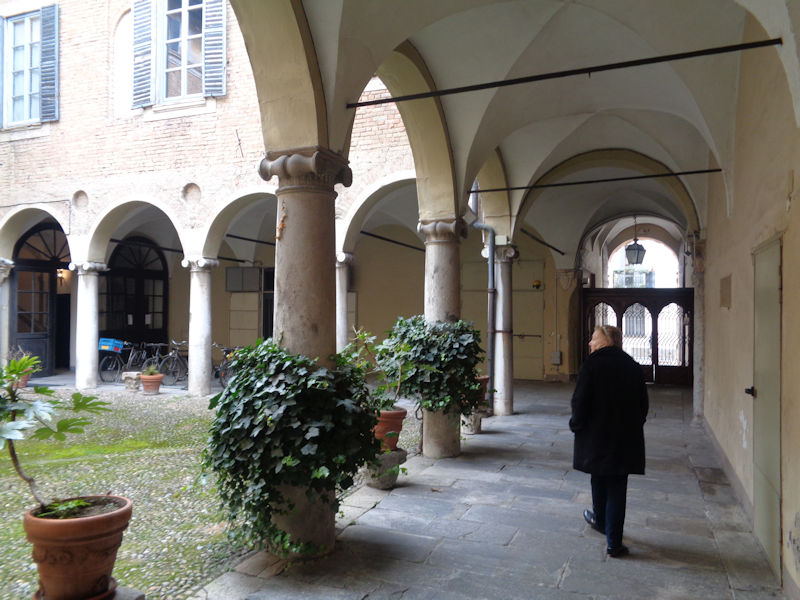
For our first full day of sightseeing, we're off at a not unreasonable hour of the morning. 21 February 2018.
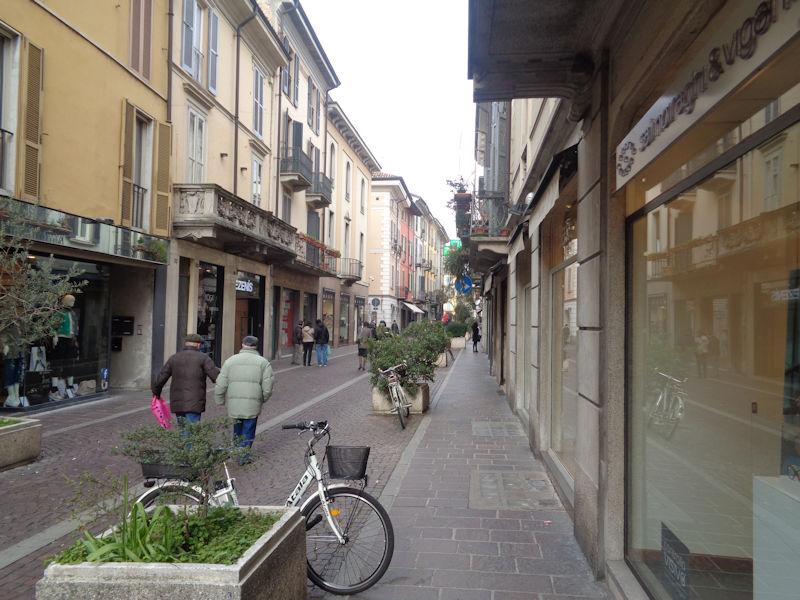
On the Corso Roma. The Lodigiani (also called the Laudensi) suffered and prospered through the years following the new city's foundation, amid the chaotic politics of northern Italy between Guelph and Ghibelline factions and periodic visits from the German Emperors. In the late 13th century, Antonio Fissiraga of an important local Guelph family who had served as the respected podestà, or temporary chief administrator, of Florence and Bologna, was a leader in 1302 of a Guelph alliance with Pavia and Piacenza to remove Matteo I Visconti from his control of Milan and restore the Guelph Della Torre or Torriani family. For which in 1303 he was elected podestà of Milan himself.

The Piazza della Vittoria. When the Emperor Henry VII of Luxembourg came into northern Italy in 1310, Ghibelline fortunes were everywhere improved, and when he arrived in Milan to receive the 'Iron Crown of Lombardy' (as King of Italy), he brought the Visconti back and appointed Matteo I as Imperial Vicar of Milan. Fissiraga's Lodi with other Guelph cities attempted unsuccessfully to resist, and the city narrowly escaped destruction; the Visconti, and their Ghibelline stand-ins in Lodi the Vistarini family, caught up with Fissiraga in 1316, however, and had him imprisoned until his death in 1327.
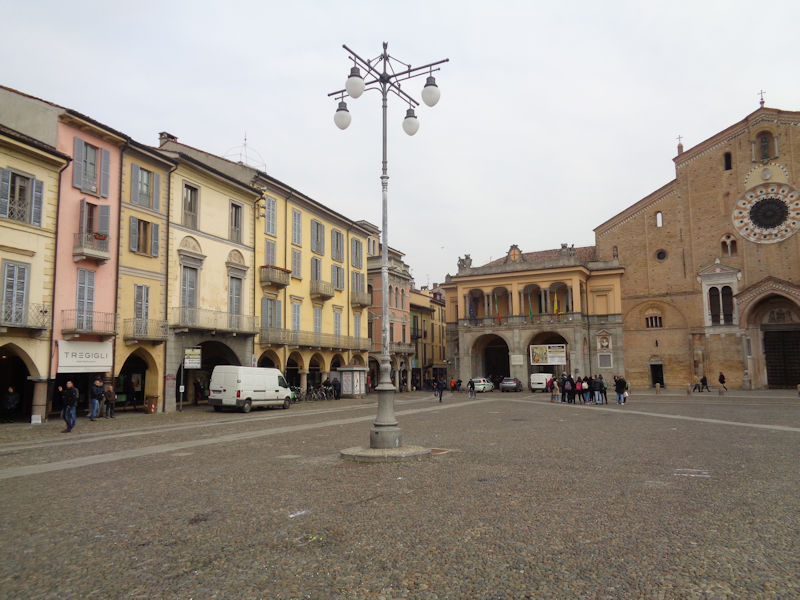
Lodi remained within the political orbit of Milan, but with the death in 1402 of Giangaleazzo Visconti, the first Duke of Milan, Giovanni Vignati of a noble Guelph family was acclaimed Lord of Lodi in 1402, with Fissiraga support, and confirmed as Count of Lodi in 1413 by Sigismund of Luxembourg, King of Hungary and later Holy Roman Emperor. During the minority of Giovanni Maria, the 2nd Duke of Milan, Vignati attempted to assert greater independence for Lodi but was betrayed in 1415 and imprisoned in Pavia, where he committed suicide. This is frequently considered the last gasp of real independence for Lodi under Milanese domination.

The Duomo. It was from the Duomo del Lodi that at the Christmas Eve Mass in 1413 the Anti-Pope John XXIII (one of three popes at the time), with the Emperor Sigismund reading the gospel, convoked the important Council of Constance (1414-1418), the apogee of the church's conciliar movement to limit absolute papal authority in temporal affairs. (Which solved the 40-year three-popes 'Western Schism' by electing a fourth.)
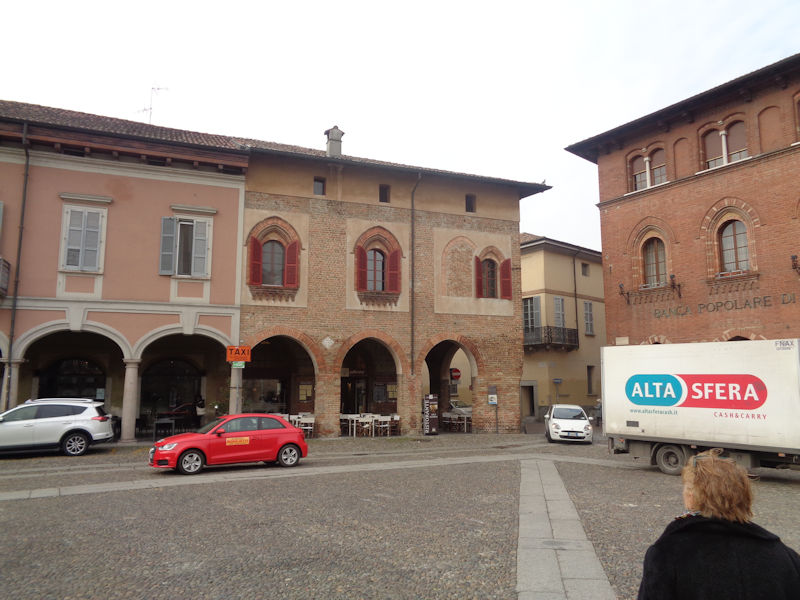
The Palazzo Vistarini, home of the Caffé Vistarini, open and modern on the ground floor, but with beautiful additional rooms down long labyrinthine corridors underground. The Palazzo was a fortified palace first built in the 14th century by the Ghibelline Vistarini family, which for centuries competed with the Guelph Fissiragas faction for power and influence within the city.
Ludovico Vistarini (1478-1556) was a famous military commander who among other feats freed Lodi from the renegade mercenary Fabrizio Maramaldo in 1526 and led the land forces in Andrea Doria's Genovese reconquest of Corsica from the French-Ottoman fleet in 1553. In 1541 he entertained the Emperor Charles V in this palace, then the Spanish soon-to-be King Philip II in 1551 and soon-to-be Emperor Maximilian II in the same year. According to the civic publication Lodi: the most outstanding figures in the history of the town, Ludovico was awarded by the city the title 'Father of the Country'.

The palace originally extended all along Corso Vittorio Emanuele II (which was originally the main road from the Milan Gate, the Porta Regale, to the Piazza della Duomo), but a great part of it was purchased in 1672 by the Barni family and renovated, beginning in 1698, as a separate baroque palace, now called the Palazzo Barni, also visitable.

We've been wandering all over in search of the Tempio Civico della Beata Vergine Incoronata -- whoever would have thought that it might be down this alley? Though the street sign's a helpful hint.
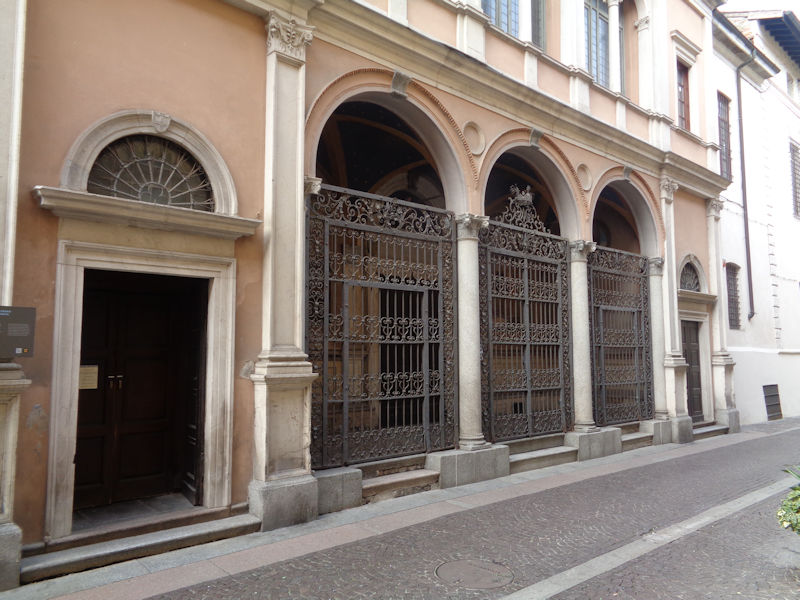
The unassuming entrance and front portico of the Incoronata -- the façade dates from 1879, but the amazing interior was designed by a student of Bramante named Battagio in 1488 and built at the city's expense over a brothel. It's 'considered one of the masterworks of the Lombard Renaissance art'.
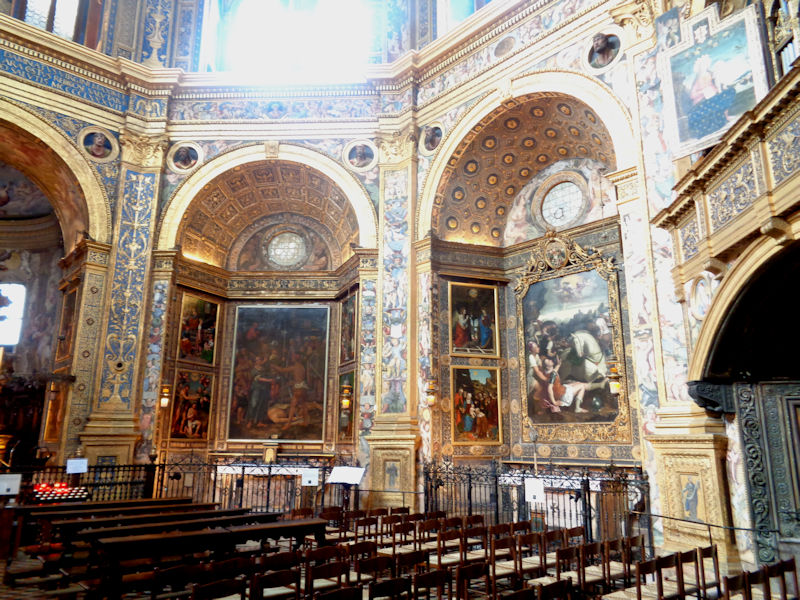
Not an inch left undecorated. There are all sorts of pictures here, mostly conventional treatments of Christian themes, and a great number of them done by the collection of Lodi painters all from the family Piazza (Martino, Albertino, and Callisto) as well as four pictures by Ambrogio Bergognone, best known for his work at the Certosa di Pavia.
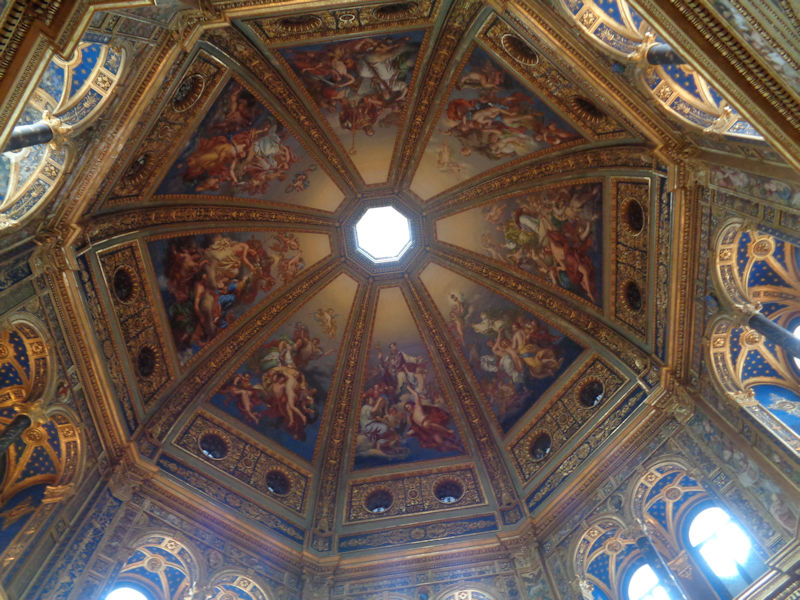
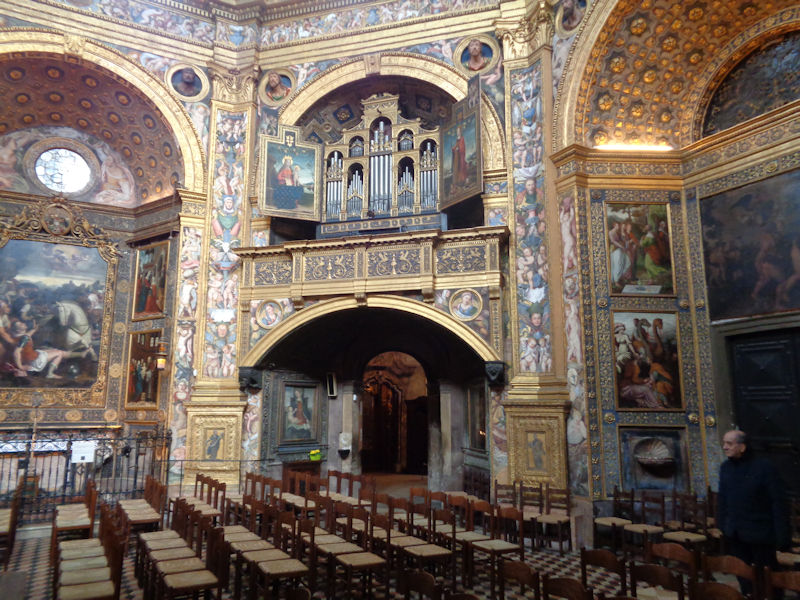
The organ is by Lorenzo of Lucca, 1507.

The main altar; there's a priest just round the back of it dozing off, awaiting a group that's beginning to file in now.

A classic beheading of St John the Baptist, with a dog who doesn't care

The group is beginning to arrive; we may just be in the way once the priest wakes up.

Next door there is the museum of the Incoronata's 'Treasures' (chasubles, crosses, croziers, probably), not open at the moment.

How awkward


Identify those 'animals'

Festivities are getting underway up in the front.

A stunning octagonal building

The Temple Incoronata down the street. The building here on the corner was built in the early 16th century for the Monte di Pietà, the medieval charitable financial institution, founded by the Franciscans, that in many cities made low-interest loans against collateral to the poor, often translated inadequately as 'the Pawnshop'. This one only ceased operations in the early 20th century.
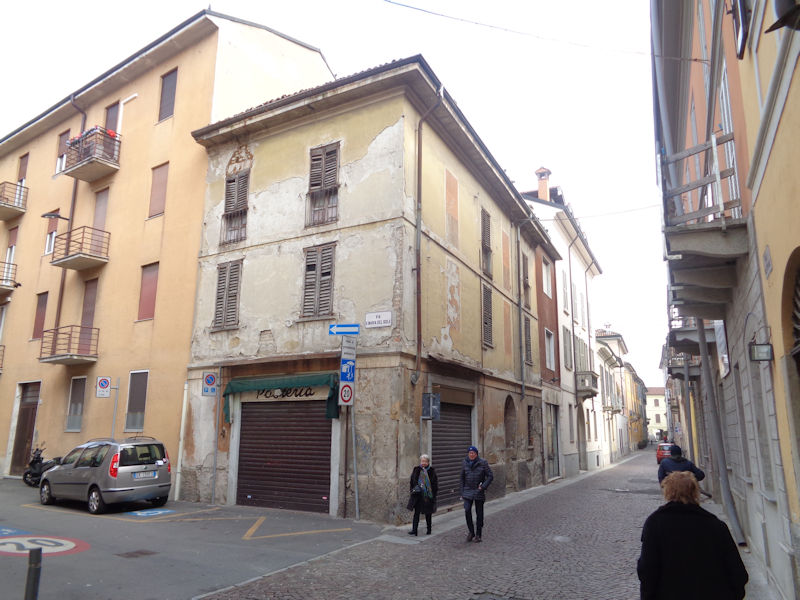
We're on the Via Solferino. Just wandering.
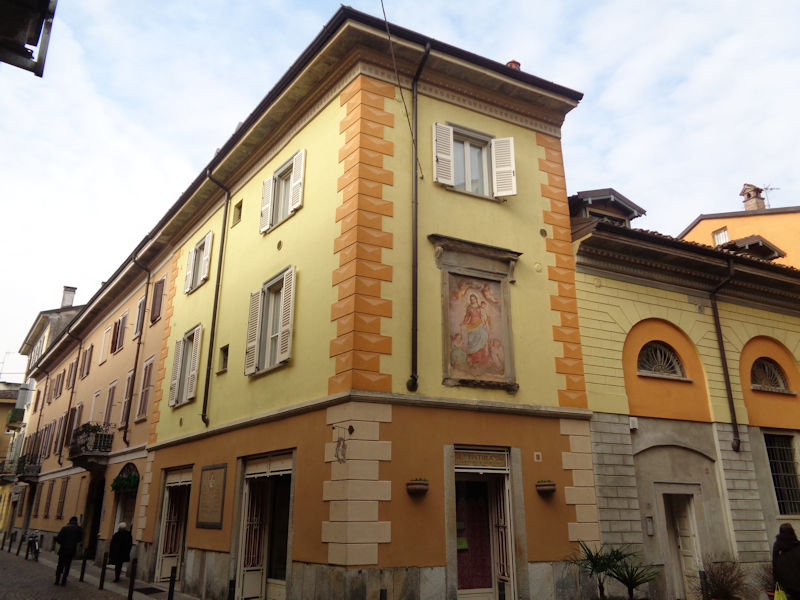
On the Via Solferino and the Via Santa Maria del Sole
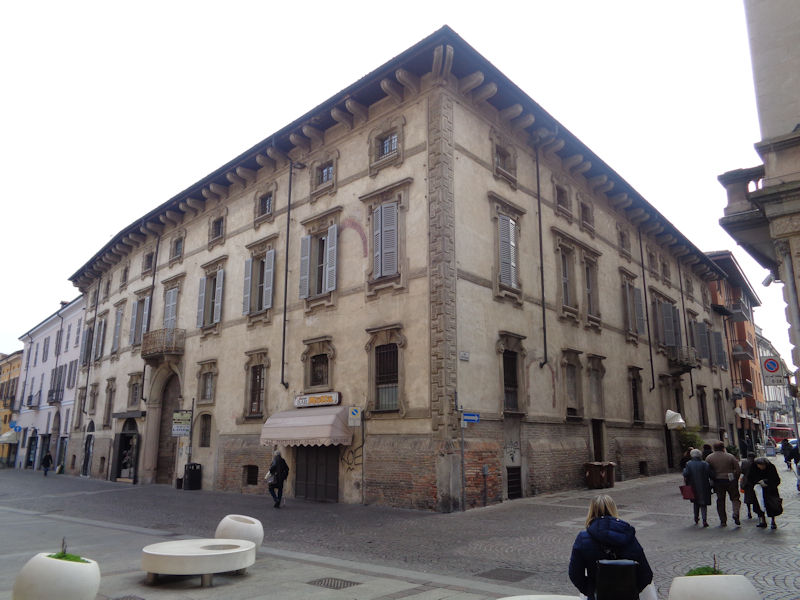
Now it's time to get serious -- we're looking for the Museo Civico on the Corso Umberto I, and it ought to be right round here, at the end of the Via Volturno.
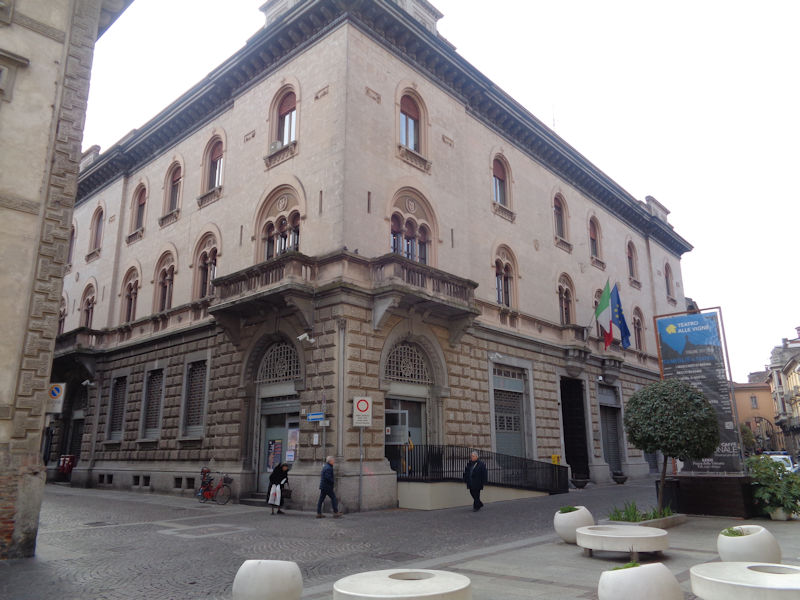
The territorial prefecture for the province, on the same little piazza

Looking back up the Corso Umberto I towards the Duomo -- no civic museum.
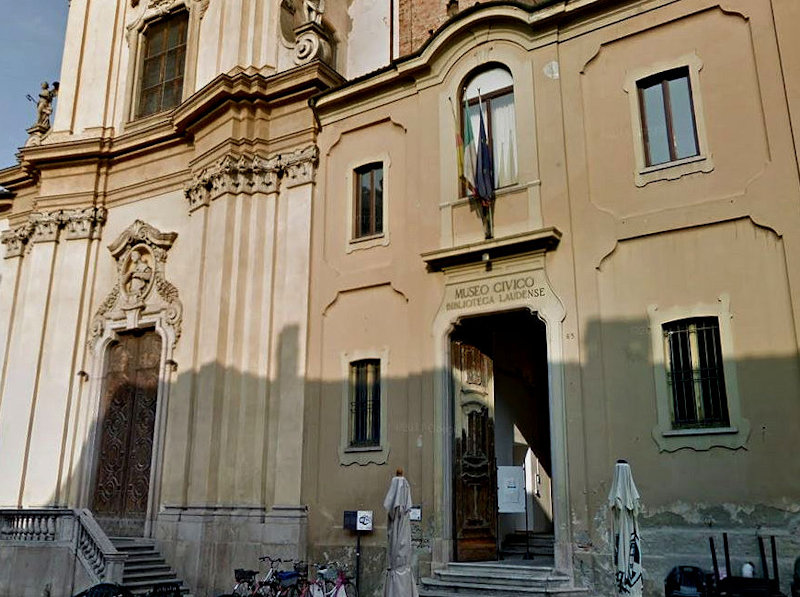
That's the Church of San Filippo Neri (1740-1745) on the left and, oh look, the Museo Civico on the right, established in 1792, and the Biblioteca Laudense (another word for 'of Lodi', from the Latin name), in the former convent variously called the Palazzo San Filippo and the Palazzo Galeano with no discernible sense to the difference.
But just to note that that's not the Museo Civico.

We'll have a look round the back. (The Via Umberto becomes the Corso Adda and the Via Lodino here.)
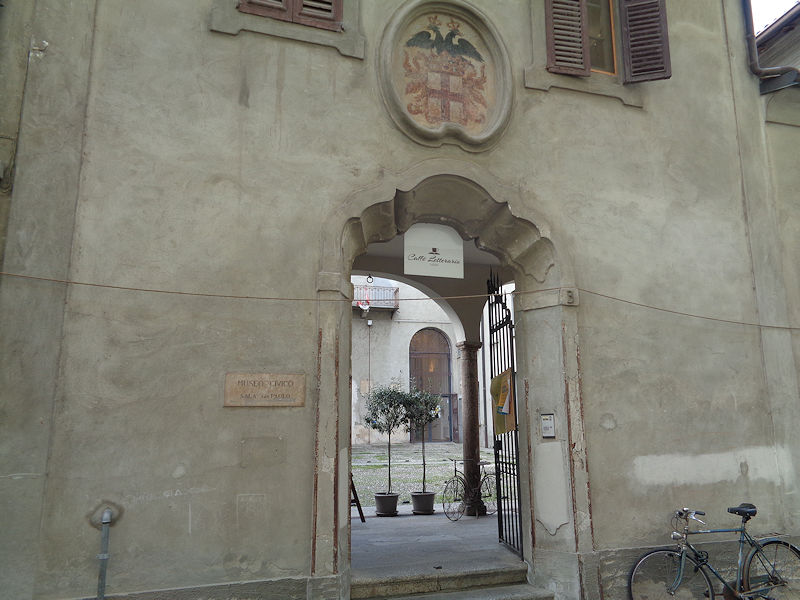
Oh good, here's the Museo Civico, round the side on the Via Tito Fanfulla. No, it's not. That's just the Caffé Letterario in a courtyard that may once have led to the Museo Civico.

It turns out, to our dismay, that the Biblioteca Comunale Laudense is now an attractive modern public library reached round the back of the Palazzo San Filippo on the Via Solferino. The building was turned into a museum and library when the religious order of the Oratory of Saint Philip Neri was suppressed by Napoleon in the 1790s. The librarians of the newly renovated facility tell us that the Civic Museum is not anywhere at the moment, but one day will be somewhere.
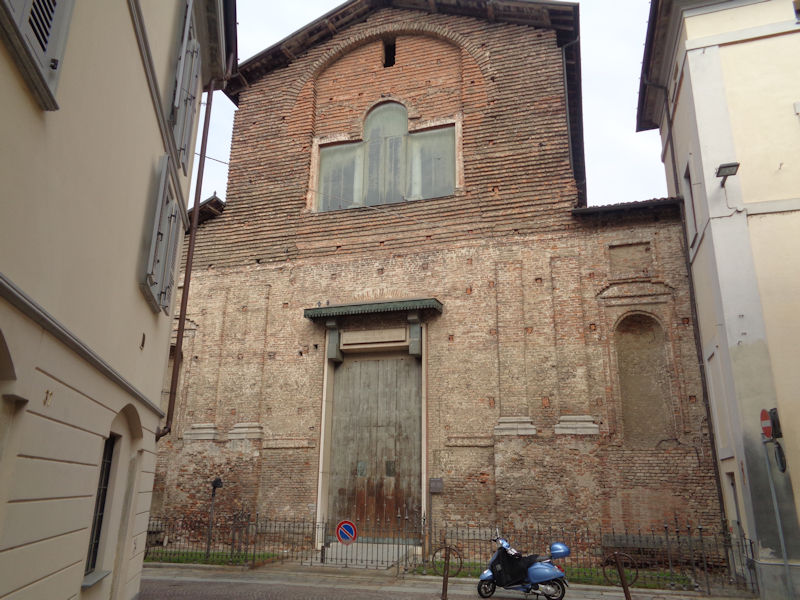
The Chiesa di San Cristoforo, a bit the worse for wear and with an unfinished façade, along with the adjacent convent of the Olivetans, was begun in 1564 by Pellegrino Tibaldi, who worked for Cardinal Borromeo around Milan and who after 1586 worked for King Philip II on the Escorial in Spain. Long used as a stable after Napoleon's arrival, it was restored in the late 1900s, though not especially well by the look of the outside of it.
We're on the Via Tito Fanfulla on the northern part of the centro storico, and it was in the Dominican monastic complex just a few meters down the street that the Treaty of Lodi (or Peace of Lodi) was signed by Milan, Florence, and the Kingdom of Naples in April 1454 which ended the 'Wars in Lombardy' (1423-1454); it established the boundaries between Milanese and Venetian spheres of control as the river Adda, and it confirmed a 'balance of power' status quo for northern Italy among those three plus Venice and the Papal States, excluding smaller powers like the Estes, Gonzagas, Savoyards, and Genovese. The treaty became irrelevant when the French armies of Charles VIII invaded northern Italy in 1494.

Now we're trudging back to the centre on the Via Santa Maria del Sole, leading to . . .

The Chiesa di Santa Maria del Sole, built 1711-1715 for the 'brotherhood of the Divina Misericordia'
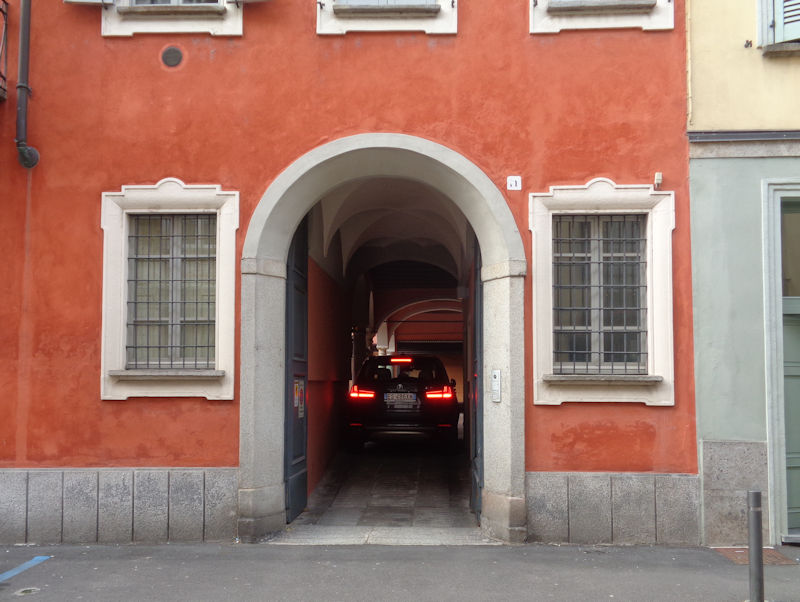
A narrow fit. Very stressful commuting to and from work!

The Angels' House on the Via Solferino
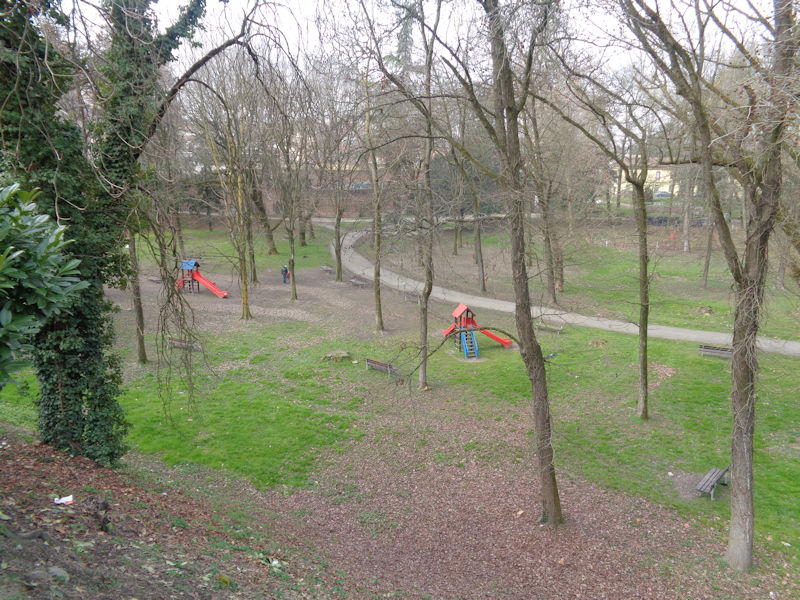
The Parco d'Isola Carolina adjacent to the centro storico and the Piazza Castello -- forlorn in winter

The Piazza Castello at the southwestern corner of the old city -- it appears that all that remains of the Visconti castle adjacent to the former Porta Regale is the tower in the background, and that the present 'castle', now the Questura di Lodi, the state police headquarters, and formerly the Austrian military barracks, came later, but that's not entirely clear.

According to the sign on the pavement by the nearby Porta Regale, in 1270 Napoleone (called 'Napo') della Torre or Torriani, effectively the Lord of Milan and at the time also podestà of Lodi (and Como, Novara, and Bergamo), built two castles in Lodi, one of them here. In 1277 Napo was defeated in battle by the forces of Ottone Visconti, Archbishop of Milan, ending Torriani rule in Milan and beginning Visconti rule that lasted until 1450. In 1370, the sign says, Barnabò Visconti built the "l'attuale castello" here, modified in the late 15th century by the Sforzas, but whether that refers only to the tower or to what is now the Questura building as well is not clear.

Fleeing the Parco d'Isola Carolina

Vittorio Emanuele II, the first king of the unified Italy -- the square and statue were put up here facing the castello in 1862, at the head of the Corso Vittorio Emanuele II leading to the Duomo, to open a thoroughfare to the station of the new railway.

The Visconti Tower and the back of the Questura from the Via Dalmazia, adjacent to . . .

. . . the Porta Regale, once the main city gate on the road towards Milan, and connected to the fortifications of the castle; it was abandoned in the late 18th century, however, when the Milan entrance to the city was moved to the Piazzale 3 Agosto at the northwestern corner of the old town. The defensive walls that ringed the old town, through which this was once the main gate, are long gone.
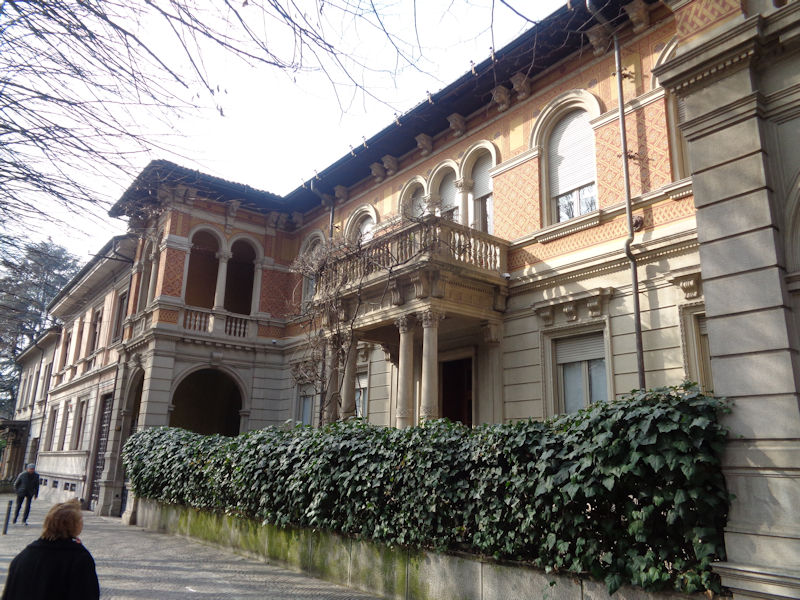
Along the Viale Dante Alighieri, approaching . . .
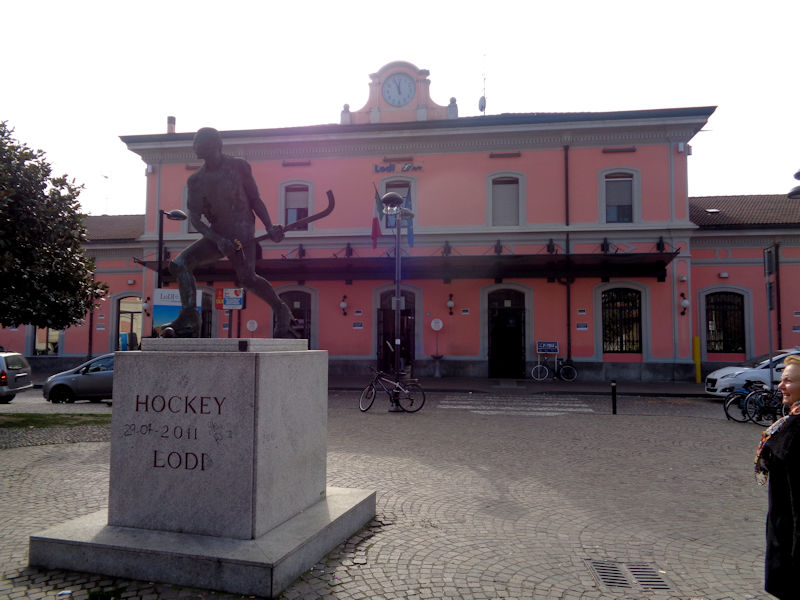
. . . the Lodi train station and the monument, not to Garibaldi or King Umberto I, but to the 2011 Lodi hockey team. We're here to get our rail tickets to Milan for a few days hence.

Between the Via Vignati and the Viale IV Novembre, there is this interesting park, half a kilometre long and only 40m across, presumably replacing the southern city wall.

We're back to the Church of St Francis in the Piazza Ospedale, and it's still closed.

Some of our party are very keen to visit the Anatomical Collection 'Paolo Gorini', souvenirs of the work of the scientist (1813-1881) who developed innovative methods for preserving cadavers. The little museum is closed, but it's housed across the square from the St Francis Church in the original part of the city hospital complex that was built in the 15th century and expanded in the 16th by Pellegrino Tibaldi.

The hospital is off limits to non-sick tourists but we are permitted to visit the 15th century cloister, with its terracotta decorations.

We'll suppress our disappointment and head off for another half hour's promenade until the church reopens. Down to the river Adda.
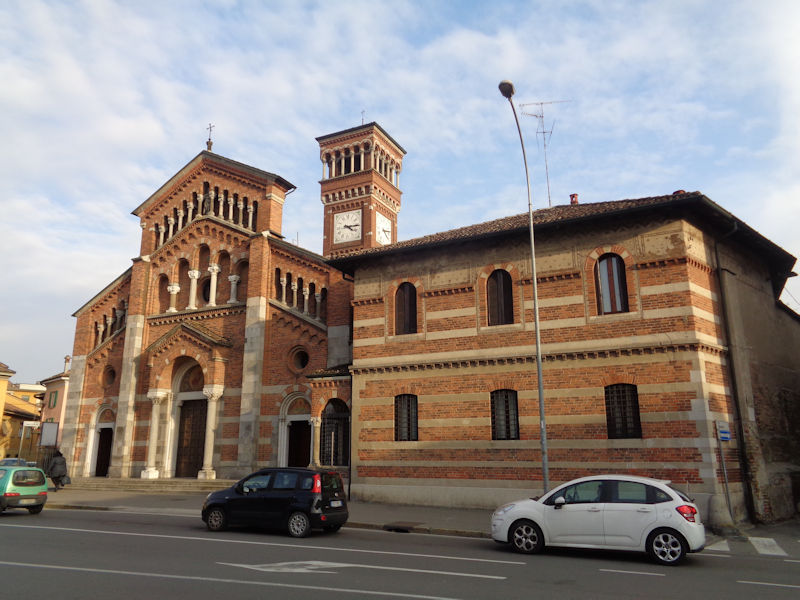
Near the bridge over the Adda, this is the odd but interesting Chiesa di San Rocco.

Still interesting, but still odd. Almost gleaming with newness.
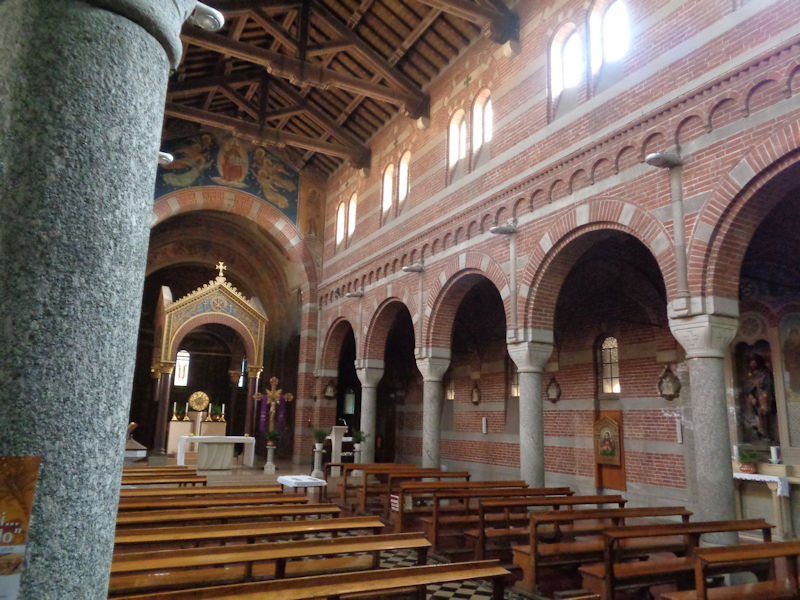
It's advertised as built in a Neo-Romanesque style -- it was begun in 1909 and completed in 1937.

This is Saint Rocco himself, patron of plague patients always shown displaying his bubo and accompanied by a faithful dog with bread in its mouth, meant for Rocco of course. St Roch or Rocco, who is said to have been a noble lad from Marseilles in the 14th century who came to northern Italy as a mendicant pilgrim and devoted himself to ministering to victims of the plague -- effecting many miraculous cures, we're told.

When Rocco came down with the illness himself, he was expelled from Piacenza to avoid contagion and went off into the wilderness alone; there he would have died but for a dog that brought him bread and healed his wounds by licking them. He was associated with the plague in many places, but during the plague years 1477-1479 his cult spread rapidly throughout northern Italy.

The Virgin of the Grotto. It was not uncommon for Italian cities to have chapels or churches dedicated to San Rocco near the gates to the city, to prevent the plague from entering, and this new church is located on the site of just such an old chapel.
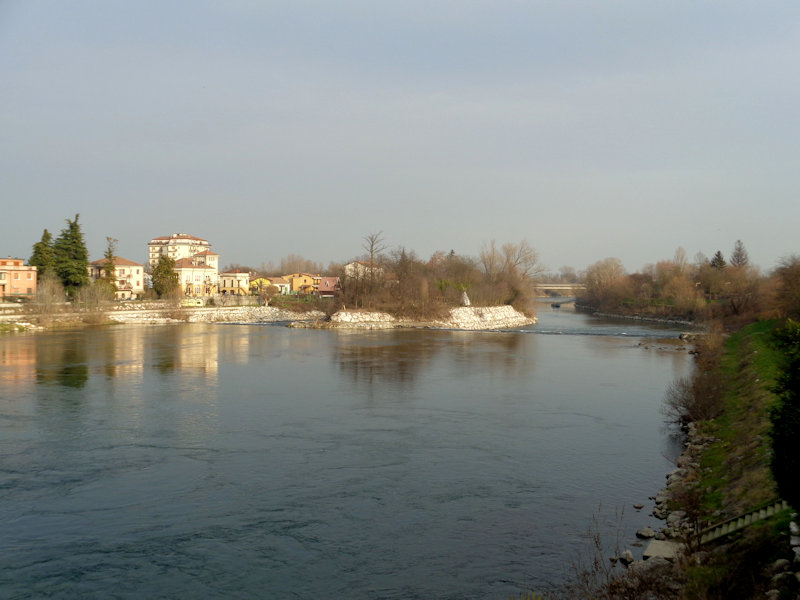
Across the river Adda
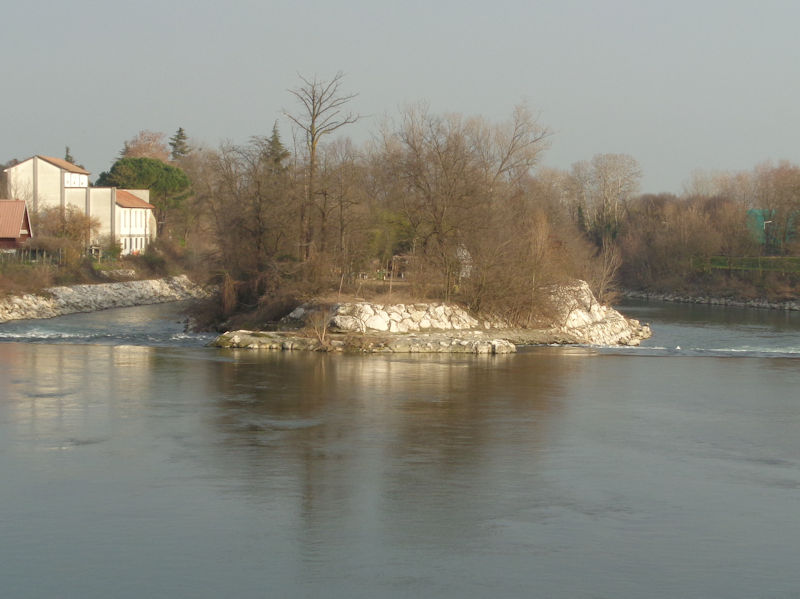
The Isolotto Achilli was until recently an abandoned, overgrown mess, but then a group of devotees got authorization and spent months clearing out the wild vegetation and trash, making it into a small park, reached by hired boat, with 'classic tepees', hammocks and 'restful bio benches', and equipment for picnicking. It apparently opened in August 2016.

On the far side of the river, this is another attraction we've been instructed not to miss: the 'Cattedrale Vegetale di Giuliano Mauri'.

The 'environmental artist' Mauri (1938-2009) made one of these in 2001, near Trento, and a second was made in Bergamo; this was built in 2016 according to his design for it and inaugurated in April 2017. Some of those things are supposed to grow into trees forming a living natural cathedral, to be appreciated by people "in search of peace, harmony and beauty".
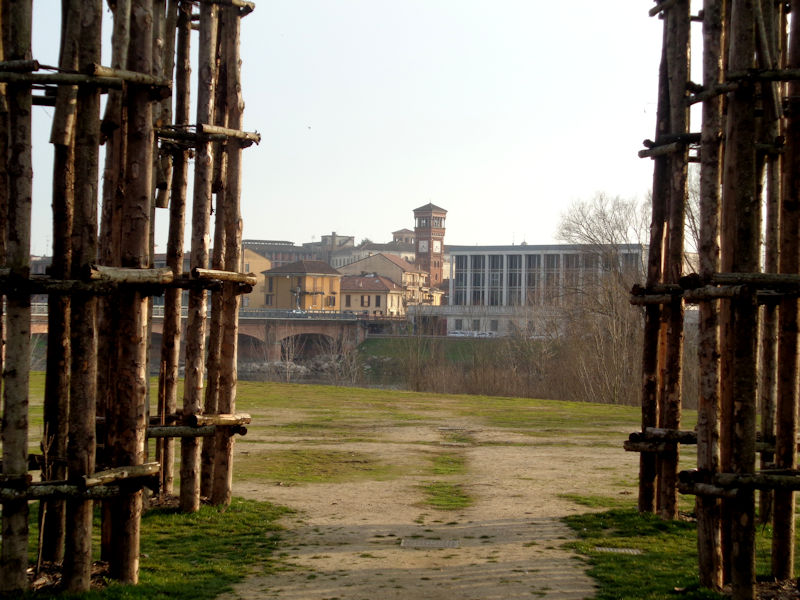
Now we're off back across the river Adda and up the hill to the Chiesa di San Francesco, said to be a good one.
Next: And still more sightseeing in Lodi.

 Dwight Peck's personal website
Dwight Peck's personal website




























































